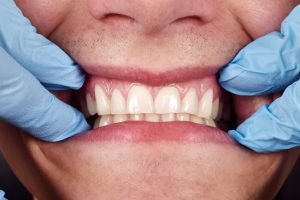 3D printing is changing the way we think about the manufacture of everything from food to teaspoons and tablespoons. Even houses can be 3D printed, apparently — but what does it mean for you? If you’re missing one or more teeth, you could benefit from the application of 3D printing in implant dentistry. One recent case study shows that using cone beam technology (CBCT), powerful planning software, and an in-house 3D printer, implant dentists can create ultra-precise guides for more efficient, predictable, and ultimately successful Houston dental implants.
3D printing is changing the way we think about the manufacture of everything from food to teaspoons and tablespoons. Even houses can be 3D printed, apparently — but what does it mean for you? If you’re missing one or more teeth, you could benefit from the application of 3D printing in implant dentistry. One recent case study shows that using cone beam technology (CBCT), powerful planning software, and an in-house 3D printer, implant dentists can create ultra-precise guides for more efficient, predictable, and ultimately successful Houston dental implants.
Dental Implants Require Precision
Dental implants are tiny titanium posts that are inserted beneath the gum line, where they act as a prosthetic root for the crown, bridge, or denture that is affixed on top. It’s a complex procedure that depends on each patient’s unique facial structure and oral anatomy. If something goes wrong, the implants may not fuse properly with the jawbone — the crucial aspect known as osseointegration that makes dental implants work so well. Successful dental implants require extreme precision, especially in more complex cases, like when significant jawbone structure has diminished as a result of the missing teeth.
At Piney Point Dental Implant Center, we work to stay on top of the latest advances in implant dentistry. We are especially excited about how 3D printing improves the process for dental implant placement.
How 3D Printing Helps Implant Placement
CBCT scans (more precise cat scans) are now the standard for dental implant placement. Most surgeons or dentists will capture the scans and use special planning software to create a model for the guides for the implant placement. This information is then sent to a separate lab, where the actual guides are created. It’s just one more step that decreases efficiency — but with 3D printing, implant dentists can complete everything in-house.
Combining the CBCT scans, special planning software, and the 3D printer, implant dentists get an ultra-precise look at the mouth, then create the special guides that make proper placement easier. Previously, the technology was too expensive for most doctors to have in-house. But with the increased popularity and accessibility of 3D printers, more patients can benefit from better, more efficient dental implant placement.
Benefits of 3D Printing for Implant Placement
Using the 3D printed limited surgical guide, dental implant placement is more efficient and predictable than dental implants placed using the traditional method. The advantages of this tactic include:
- Guide carefully controls how deep the drill goes
- No need for repeated drilling
- More cost efficient
- Implants last as long as those placed the traditional way
- Faster, more comfortable surgery
Visit Piney Point Dental Implant Center in Houston!
Dr. Koo and the team at Piney Point Dental Implant Center stay on top of the latest in dental implant technology, and that includes the possibilities with 3D printing. Are you already missing or on the brink of extracting one or more teeth? Then you need to find out whether or not dental implants are a possibility for you. Please get in touch with our office to schedule an appointment today!

